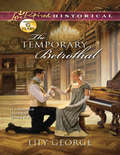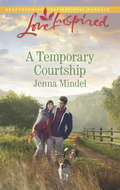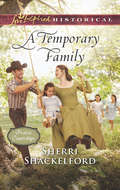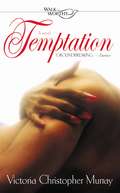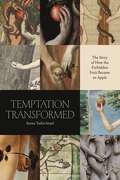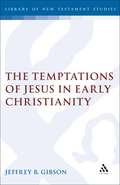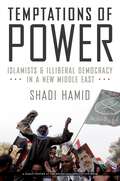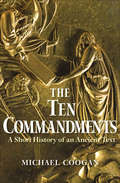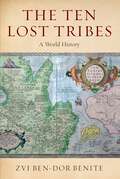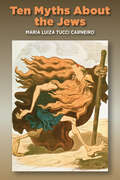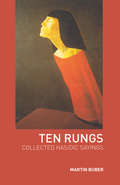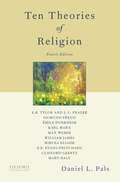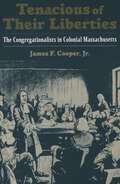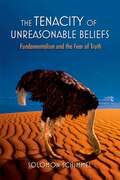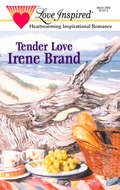- Table View
- List View
The Temporary Betrothal (Mills And Boon Love Inspired Historical Ser.)
by Lily GeorgeFROM TEMPORARY ENGAGEMENT TO TRUE LOVE? Sophie Handley is a charming flirt—just like the fiancée who jilted Charles Cantrill after he was wounded at Waterloo. Yet her assistance in helping veterans is proving invaluable. And when she offers to feign a courtship to appease his family, he finds their arrangement curiously appealing….
A Temporary Courtship: The Rancher's Texas Match Loving Isaac A Temporary Courtship (Maple Springs #3)
by Jenna MindelAn Inconvenient Attraction
A Temporary Family: Pony Express Mail-order Bride A Temporary Family Her Motherhood Wish Frontier Agreement (Prairie Courtships #4)
by Sherri ShackelfordMAKE-BELIEVE MARRIAGE
Temptation: The Aftermath
by Victoria Christopher MurrayKyla and Jefferson Blake count their 16 years together as a wonderful blessing from God. Their marriage is passionate, their daughter is a joy, Jefferson's medial career is prospering and they have loyal friends. Kyla knows her newly divorced and lifelong friend, Jasmine, is desperately unhappy and no amount of prayer or encouragement seems to help. But what Kyla doesn't know is that Jasmine has a plan to move her life forward with the type of man she feels she should have married in the first place. A man like Jefferson. Alexis Ward, Kyla's, best friend, is single and successful and willing to wait for the right man for all the right reasons. But, when "Mr. Right," Dr. Brian Lewis, finally appears she finds herself facing a new challenge. Does she really have to walk away from what she believes in order to have a man in her life? As people who love God, Kyla, Jefferson and Alexis discover, each in their own way, what happens when they truly allow God to be first in their relationships. Full of contemporary characters who struggle to keep their strength, friendships and daily lives framed by the Word of God, Temptation is a novel no reader will soon forget.
Temptation Transformed: The Story of How the Forbidden Fruit Became an Apple
by Azzan Yadin-IsraelA journey into the mystery behind why the forbidden fruit became an apple, upending an explanation that stood for centuries. How did the apple, unmentioned by the Bible, become the dominant symbol of temptation, sin, and the Fall? Temptation Transformed pursues this mystery across art and religious history, uncovering where, when, and why the forbidden fruit became an apple. Azzan Yadin-Israel reveals that Eden’s fruit, once thought to be a fig or a grape, first appears as an apple in twelfth-century French art. He then traces this image back to its source in medieval storytelling. Though scholars often blame theologians for the apple, accounts of the Fall written in commonly spoken languages—French, German, and English—influenced a broader audience than cloistered Latin commentators. Azzan Yadin-Israel shows that, over time, the words for “fruit” in these languages narrowed until an apple in the Garden became self-evident. A wide-ranging study of early Christian thought, Renaissance art, and medieval languages, Temptation Transformed offers an eye-opening revisionist history of a central religious icon.
Temptation Transformed: The Story of How the Forbidden Fruit Became an Apple
by Azzan Yadin-IsraelA journey into the mystery behind why the forbidden fruit became an apple, upending an explanation that stood for centuries. How did the apple, unmentioned by the Bible, become the dominant symbol of temptation, sin, and the Fall? Temptation Transformed pursues this mystery across art and religious history, uncovering where, when, and why the forbidden fruit became an apple. Azzan Yadin-Israel reveals that Eden’s fruit, once thought to be a fig or a grape, first appears as an apple in twelfth-century French art. He then traces this image back to its source in medieval storytelling. Though scholars often blame theologians for the apple, accounts of the Fall written in commonly spoken languages—French, German, and English—influenced a broader audience than cloistered Latin commentators. Azzan Yadin-Israel shows that, over time, the words for “fruit” in these languages narrowed until an apple in the Garden became self-evident. A wide-ranging study of early Christian thought, Renaissance art, and medieval languages, Temptation Transformed offers an eye-opening revisionist history of a central religious icon.
Temptation Transformed: The Story of How the Forbidden Fruit Became an Apple
by Azzan Yadin-IsraelA "brisk and entertaining" (Wall Street Journal) journey into the mystery behind why the forbidden fruit became an apple, upending an explanation that stood for centuries. How did the apple, unmentioned by the Bible, become the dominant symbol of temptation, sin, and the Fall? Temptation Transformed pursues this mystery across art and religious history, uncovering where, when, and why the forbidden fruit became an apple. Azzan Yadin-Israel reveals that Eden’s fruit, once thought to be a fig or a grape, first appears as an apple in twelfth-century French art. He then traces this image back to its source in medieval storytelling. Though scholars often blame theologians for the apple, accounts of the Fall written in commonly spoken languages—French, German, and English—influenced a broader audience than cloistered Latin commentators. Azzan Yadin-Israel shows that, over time, the words for “fruit” in these languages narrowed until an apple in the Garden became self-evident. A wide-ranging study of early Christian thought, Renaissance art, and medieval languages, Temptation Transformed offers an eye-opening revisionist history of a central religious icon.
The Temptations of Jesus in Early Christianity (The Library of New Testament Studies #112)
by Jeffrey GibsonThis study lays the groundwork necessary for establishing the validity of the thesis, proposed particulary by J.H. Yoder in his Politics of Jesus, that the early church held a selective and unified view of the nature and content of the various temptations to which Jesus was regarded as having been subjected in his lifetime. This leads to a clearer view of how the early church perceived the exigencies of its Lord's mission and message, and provides fresh insights into such prominent New Testament themes as sonship, obedience, faithfulness and discipleship. It also opens up new possibilities for firmly establishing the occasion of those New Testament writings, such as the Gospel of Mark and even the Epistle to the Hebrews, where notice of and appeal to the example of Jesus in temptation appears as a prominent feature.
Temptations of Power: Islamists and Illiberal Democracy in a New Middle East
by Shadi HamidIn 1989, Francis Fukuyama famously announced the "end of history." The Berlin Wall had fallen; liberal democracy had won out. But what of illiberal democracy--the idea that popular majorities, working through the democratic process, might reject gender equality, religious freedoms, and other norms that Western democracies take for granted? Nowhere have such considerations become more relevant than in the Middle East, where the uprisings of 2011 swept the Muslim Brotherhood and other Islamist groups to power. In Temptations of Power, Shadi Hamid draws on hundreds of interviews with leaders and activists from across the region to advance a new understanding of how Islamist movements change over time. He puts forward the bold thesis that repression "forced" Islamists to moderate their politics, work in coalitions, de-emphasize Islamic law, and set aside the dream of an Islamic state. Meanwhile, democratic openings in the 1980s--and again during the Arab Spring--pushed Islamists back toward their original conservatism. With the uprisings of 2011, Islamists found themselves in an enviable position, but one for which they were unprepared. Groups like the Brotherhood combine the features of both political parties and religious movements, leading to an inherent tension they have struggled to resolve. However pragmatic they may be, their ultimate goal remains the Islamization of society. When the electorate they represent is conservative as well, they can push their own form of illiberal democracy while insisting they are carrying out the popular will. This can lead to overreach and significant backlash. Yet, while the Egyptian coup and the subsequent crackdown were a devastating blow for the Islamist "project," obituaries of political Islam are premature. As long as the battle over the role of religion in public life continues, Islamist parties in countries as diverse as Egypt, Tunisia, and Jordan will remain an important force whether in the ranks of opposition or the halls of power. But what are the key factors driving their evolution? A timely and provocative reassessment, Hamid's account serves as an essential compass for those trying to understand where the region's varied Islamist groups have come from and where they might be headed.
Temptations of Power: Islamists and Illiberal Democracy in a New Middle East
by Shadi HamidIn 1989, Francis Fukuyama famously announced the "end of history." The Berlin Wall had fallen; liberal democracy had won out. But what of illiberal democracy--the idea that popular majorities, working through the democratic process, might reject gender equality, religious freedoms, and other norms that Western democracies take for granted? Nowhere have such considerations become more relevant than in the Middle East, where the uprisings of 2011 swept the Muslim Brotherhood and other Islamist groups to power. In Temptations of Power, Shadi Hamid draws on hundreds of interviews with leaders and activists from across the region to advance a new understanding of how Islamist movements change over time. He puts forward the bold thesis that repression "forced" Islamists to moderate their politics, work in coalitions, de-emphasize Islamic law, and set aside the dream of an Islamic state. Meanwhile, democratic openings in the 1980s--and again during the Arab Spring--pushed Islamists back toward their original conservatism. With the uprisings of 2011, Islamists found themselves in an enviable position, but one for which they were unprepared. Groups like the Brotherhood combine the features of both political parties and religious movements, leading to an inherent tension they have struggled to resolve. However pragmatic they may be, their ultimate goal remains the Islamization of society. When the electorate they represent is conservative as well, they can push their own form of illiberal democracy while insisting they are carrying out the popular will. This can lead to overreach and significant backlash. Yet, while the Egyptian coup and the subsequent crackdown were a devastating blow for the Islamist "project," obituaries of political Islam are premature. As long as the battle over the role of religion in public life continues, Islamist parties in countries as diverse as Egypt, Tunisia, and Jordan will remain an important force whether in the ranks of opposition or the halls of power. But what are the key factors driving their evolution? A timely and provocative reassessment, Hamid's account serves as an essential compass for those trying to understand where the region's varied Islamist groups have come from and where they might be headed.
The Ten Commandments: A Short History of an Ancient Text
by Michael CooganIn this lively and provocative book, Michael Coogan guides readers into the ancient past to examine the iconic Ten Commandments, also known as the Decalogue. How, among all the laws reportedly given on Mount Sinai, did the Ten Commandments become the Ten Commandments? When did that happen? There are several versions of the Decalogue in the Old Testament, so how have different groups determined which is the most authoritative? Why were different versions created? Coogan discusses the meanings the Ten Commandments had for audiences in biblical times and observes that the form of the ten proscriptions and prohibitions was not fixed—as one would expect since they were purported to have come directly from God—nor were the Commandments always strictly observed. In later times as well, Jews and especially Christians ignored and even rejected some of the prohibitions, although the New Testament clearly acknowledges the special status of the Ten Commandments. Today it is plain that some of the values enshrined in the Decalogue are no longer defensible, such as the ownership of slaves and the labeling of women as men’s property. Yet in line with biblical precedents, the author concludes that while a literal observance of the Ten Commandments is misguided, some of their underlying ideals remain valid in a modern context.
The Ten Lost Tribes: A World History
by Zvi Ben-Dor BeniteThe legendary story of the ten lost tribes of Israel has resonated among both Jews and Christians down through the centuries: the compelling idea that some core group of humanity was ''lost'' and exiled to a secret place, perhaps someday to return triumphant. In The Ten Lost Tribes, Zvi Ben-Dor Benite shows for the first time the extent to which the search for the lost tribes of Israel became, over two millennia, an engine for global exploration and a key mechanism for understanding the world. As the book reveals, the quest for the missing tribes and the fervent belief that their restitution marked a necessary step toward global redemption have been threaded through countless historical moments--from the formation of the first ''world'' empires to the age of discovery, and from the spread of European imperialism to the rise of modern-day evangelical apocalypticism. More than a historical survey of an enduring myth, The Ten Lost Tribes offers a unique prism through which to view the many facets of encounters between cultures, the processes of colonization, and the growth of geographical knowledge.
The Ten Lost Tribes: A World History
by Zvi Ben-Dor BeniteThe legendary story of the ten lost tribes of Israel has resonated among both Jews and Christians down through the centuries: the compelling idea that some core group of humanity was ''lost'' and exiled to a secret place, perhaps someday to return triumphant. In The Ten Lost Tribes, Zvi Ben-Dor Benite shows for the first time the extent to which the search for the lost tribes of Israel became, over two millennia, an engine for global exploration and a key mechanism for understanding the world. As the book reveals, the quest for the missing tribes and the fervent belief that their restitution marked a necessary step toward global redemption have been threaded through countless historical moments--from the formation of the first ''world'' empires to the age of discovery, and from the spread of European imperialism to the rise of modern-day evangelical apocalypticism. More than a historical survey of an enduring myth, The Ten Lost Tribes offers a unique prism through which to view the many facets of encounters between cultures, the processes of colonization, and the growth of geographical knowledge.
Ten Myths About the Jews
by Maria CarneiroTen Myths about the Jews analyzes the complex facets of anti-Semitism and anti-Judaism in an accessible and easy-to-read format. Based on wide research, Brazilian historian Maria Luiza Tucci Carneiro examines different manifestations against Jews and their faith through history and political culture along the centuries. Ten omnipresent accusations were configured by anti-Semites in axioms that became myths: Myth 1: The Jews killed Christ. Myth 2: The Jews are a secret entity. Myth 3: The Jews control the world economy. Myth 4: There are no poor Jews. Myth 5: The Jews are greedy. Myth 6: The Jews have no homeland. Myth 7: The Jews are racists. Myth 8: The Jews are parasites. Myth 9: The Jews control the media. Myth 10: The Jews manipulate the United States. Tucci Carneiro unmasks the roots of anti-Semitism and exposes contemporary prejudices. Her book is an invitation to reflect upon current realities marked by racism and shows how the main myths about the Jews have been vested of a verisimilitude that has persisted for the last 2000 years, all over the world, by means of hatred of the other, political/religious opportunism and economic deceit. The myths are kept alive by means of constant repetition and re-elaboration of a particular narrative, invariably seductive. The author proves each of the ten myths in terms of their historical record, their origins and purposes. Even though Jews are fully integrated into western society in multiple ways (entrepreneurship, medicine, literature, philosophy, the arts), racist myths against the community have been particularly resilient; they attempt to override common sense and their continuous circulation and rehashing through scapegoating and caricature has had profound negative repercussions for society as a whole. Ten Myths, now published in five languages, is an essential tool in the struggle against the discourse of racist hatred.
Ten Myths About the Jews
by Maria Luiza CarneiroTen Myths about the Jews analyzes the complex facets of anti-Semitism and anti-Judaism in an accessible and easy-to-read format. Based on wide research, Brazilian historian Maria Luiza Tucci Carneiro examines different manifestations against Jews and their faith through history and political culture along the centuries. Ten omnipresent accusations were configured by anti-Semites in axioms that became myths: Myth 1: The Jews killed Christ. Myth 2: The Jews are a secret entity. Myth 3: The Jews control the world economy. Myth 4: There are no poor Jews. Myth 5: The Jews are greedy. Myth 6: The Jews have no homeland. Myth 7: The Jews are racists. Myth 8: The Jews are parasites. Myth 9: The Jews control the media. Myth 10: The Jews manipulate the United States. Tucci Carneiro unmasks the roots of anti-Semitism and exposes contemporary prejudices. Her book is an invitation to reflect upon current realities marked by racism and shows how the main myths about the Jews have been vested of a verisimilitude that has persisted for the last 2000 years, all over the world, by means of hatred of the other, political/religious opportunism and economic deceit. The myths are kept alive by means of constant repetition and re-elaboration of a particular narrative, invariably seductive. The author proves each of the ten myths in terms of their historical record, their origins and purposes. Even though Jews are fully integrated into western society in multiple ways (entrepreneurship, medicine, literature, philosophy, the arts), racist myths against the community have been particularly resilient; they attempt to override common sense and their continuous circulation and rehashing through scapegoating and caricature has had profound negative repercussions for society as a whole. Ten Myths, now published in five languages, is an essential tool in the struggle against the discourse of racist hatred.
Ten Rungs: Collected Hasidic Sayings
by Martin BuberThe sacred tales and aphorisms collected here by Martin Buber have their origins in the traditional Hasidic metaphor of life as a ladder, reaching towards the divine by ascending rungs of perfection. Through Biblical riddles and interpretations, Jewish proverbs and spiritual meditations, they seek to awaken in the reader a full awareness of the urgency of the human condition, and of the great need for self-recognition and spiritual renewal.
Ten Rungs: Collected Hasidic Sayings
by Martin BuberThe sacred tales and aphorisms collected here by Martin Buber have their origins in the traditional Hasidic metaphor of life as a ladder, reaching towards the divine by ascending rungs of perfection. Through Biblical riddles and interpretations, Jewish proverbs and spiritual meditations, they seek to awaken in the reader a full awareness of the urgency of the human condition, and of the great need for self-recognition and spiritual renewal.
Ten Rungs: Collected Hasidic Sayings
by Martin BuberThe sacred tales and aphorisms collected here by Martin Buber have their origins in the traditional Hasidic metaphor of life as a ladder, reaching towards the divine by ascending rungs of perfection. Through Biblical riddles and interpretations, Jewish proverbs and spiritual meditations, they seek to awaken in the reader a full awareness of the urgency of the human condition, and of the great need for self-recognition and spiritual renewal.
Ten Rungs: Collected Hasidic Sayings
by Martin BuberThe sacred tales and aphorisms collected here by Martin Buber have their origins in the traditional Hasidic metaphor of life as a ladder, reaching towards the divine by ascending rungs of perfection. Through Biblical riddles and interpretations, Jewish proverbs and spiritual meditations, they seek to awaken in the reader a full awareness of the urgency of the human condition, and of the great need for self-recognition and spiritual renewal.
Ten Theories of Religion
by Daniel PalsWhy do human beings believe in divinities? Why do some seek eternal life, while others seek escape from recurring lives? Why do the beliefs and behaviors we typically call "religious" so deeply affect the human personality and so subtly weave their way through human society? Ideal as a supplementary text in introductory religion courses or as the main text in theory and method in religious studies or in sociology of religion courses, Ten Theories of Religion, Fourth Edition, offers an illuminating treatment of this controversial and fascinating subject.
Tenacious of Their Liberties: The Congregationalists in Colonial Massachusetts (Religion in America)
by James F. CooperAlthough the importance of Congregationalism in early Massachusetts has engaged historians' attention for generations, this study is the first to approach the Puritan experience in Congregational church government from the perspective of both the pew and the pulpit. For the past decade, author James F. Cooper, Jr. has immersed himself in local manuscript church records. These previously untapped documents provide a fascinating glimpse of lay-clerical relations in colonial Massachusetts, and reveal that ordinary churchgoers shaped the development of Congregational practices as much as the clerical and elite personages who for so long have populated histories of this period. Cooper's new findings will both challenge existing models of church hierarchy and offer a new dimension to our understanding of the origins of New England democracy. Refuting the idea of clerical predominance in the governance of colonial Massachusetts churches, Cooper shows that the laity were both informed and empowered to rule with ministers, rather than beneath them. From the outset of the Congregational experiment, ministers articulated--and lay people embraced--principles of limited authority, higher law, and free consent in the conduct of church affairs. These principles were codified early on in the Cambridge Platform, which the laity used as their standard in resisting infringements upon their rights. By neglecting the democratic components of Congregationalism, Cooper argues, scholars have missed the larger political significance of the movement. Congregational thought and practice in fact served as one indigenous seedbed of several concepts that would later flourish during the Revolutionary generation, including the notions that government derives its legitimacy from the voluntary consent of the governed, that governors should be chosen by the governed, that rulers should be accountable to the ruled, and that constitutional checks should limit both the governors and the people. By examining the development of church government through the perspective of lay-clerical interchange, Cooper comes to a fresh understanding of the sometimes noble, sometimes sordid, and sometimes rowdy nature of church politics. His study casts new light upon Anne Hutchinson and the "Antinomian Controversy," the Cambridge Platform, the Halfway Covenant, the Reforming Synod of 1679, and the long-standing debate over Puritan "declension." Cooper argues that, in general, church government did not divide Massachusetts culture along lay-clerical lines, but instead served as a powerful component of a popular religion and an ideology whose fundamentals were shared by churchgoers and most ministers throughout much of the colonial era. His is a book that will interest students of American culture, religion, government, and history.
Tenacious Of Their Liberties: The Congregationalists In Colonial Massachusetts
by James F. Cooper James Fenimore CooperAlthough the importance of Congregationalism in early Massachusetts has engaged historians' attention for generations, this study is the first to approach the Puritan experience in Congregational church government from the perspective of both the pewandthe pulpit. For the past decade, author James F. Cooper, Jr. has immersed himself in local manuscript church records. These previously untapped documents provide a fascinating glimpse of lay-clerical relations in colonial Massachusetts, and reveal that ordinary churchgoers shaped the development of Congregational practices as much as the clerical and elite personages who for so long have populated histories of this period. Cooper's new findings will both challenge existing models of church hierarchy and offer a new dimension to our understanding of the origins of New England democracy. Refuting the idea of clerical predominance in the governance of colonial Massachusetts churches, Cooper shows that the laity were both informed and empowered to rulewithministers, rather than beneath them. From the outset of the Congregational experiment, ministers articulated--and lay people embraced--principles of limited authority, higher law, and free consent in the conduct of church affairs. These principles were codified early on in the Cambridge Platform, which the laity used as their standard in resisting infringements upon their rights. By neglecting the democratic components of Congregationalism, Cooper argues, scholars have missed the larger political significance of the movement. Congregational thought and practice in fact served as one indigenous seedbed of several concepts that would later flourish during the Revolutionary generation, including the notions that government derives its legitimacy from the voluntary consent of the governed, that governors should be chosen by the governed, that rulers should be accountable to the ruled, and that constitutional checks should limit both the governors and the people. By examining the development of church government through the perspective of lay-clerical interchange, Cooper comes to a fresh understanding of the sometimes noble, sometimes sordid, and sometimes rowdy nature of church politics. His study casts new light upon Anne Hutchinson and the "Antinomian Controversy," the Cambridge Platform, the Halfway Covenant, the Reforming Synod of 1679, and the long-standing debate over Puritan "declension." Cooper argues that, in general, church government did not divide Massachusetts culture along lay-clerical lines, but instead served as a powerful component of a popular religion and an ideology whose fundamentals were shared by churchgoers and most ministers throughout much of the colonial era. His is a book that will interest students of American culture, religion, government, and history.
The Tenacity of Unreasonable Beliefs: Fundamentalism and the Fear of Truth
by Solomon SchimmelThe Tenacity of Unreasonable Beliefs is a passionate yet analytical critique of Jewish, Christian, and Muslim scriptural fundamentalists. Schimmel examines the ways in which otherwise intelligent and bright Jews, Christians, and Muslims defend their belief in the divine authorship of the Bible or of the Koran, and other religious beliefs derived from those claims, against overwhelming evidence and argument to the contrary from science, scholarship, common sense, and rational analysis. He also examines the motives, fears, and anxieties of scriptural fundamentalists that induce them to cling so tenaciously to their unreasonable beliefs. Schimmel begins with reflections on his own journey from commitment to Orthodox Judaism, through doubts about its theological dogmas and doctrines, to eventual denial of their truth. He follows this with an examination of theological and philosophical debates about the proper relationships between faith, reason, and revelation. Schimmel then devotes separate chapters to Jewish, Christian, and Muslim scriptural fundamentalism, noting their similarities and differences. He analyzes in depth the psychological and social reasons why people acquire, maintain, and protect unreasonable religious beliefs, and how they do so. Schimmel also discusses unethical and immoral consequences of scriptural fundamentalism, such as gender inequality, homophobia, lack of intellectual honesty, self-righteousness, intolerance, propagation of falsehood, and in some instances, the advocacy of violence and terrorism. He concludes with a discussion of why, when, and where it is appropriate to critique, challenge, and combat scriptural fundamentalists. The Tenacity of Unreasonable Beliefs is thoughtful and provocative, written to encourage self-reflection and self-criticism, and to stimulate and to enlighten all who are interested in the psychology of religion and in religious fundamentalism.
The Tenacity of Unreasonable Beliefs: Fundamentalism and the Fear of Truth
by Solomon SchimmelThe Tenacity of Unreasonable Beliefs is a passionate yet analytical critique of Jewish, Christian, and Muslim scriptural fundamentalists. Schimmel examines the ways in which otherwise intelligent and bright Jews, Christians, and Muslims defend their belief in the divine authorship of the Bible or of the Koran, and other religious beliefs derived from those claims, against overwhelming evidence and argument to the contrary from science, scholarship, common sense, and rational analysis. He also examines the motives, fears, and anxieties of scriptural fundamentalists that induce them to cling so tenaciously to their unreasonable beliefs. Schimmel begins with reflections on his own journey from commitment to Orthodox Judaism, through doubts about its theological dogmas and doctrines, to eventual denial of their truth. He follows this with an examination of theological and philosophical debates about the proper relationships between faith, reason, and revelation. Schimmel then devotes separate chapters to Jewish, Christian, and Muslim scriptural fundamentalism, noting their similarities and differences. He analyzes in depth the psychological and social reasons why people acquire, maintain, and protect unreasonable religious beliefs, and how they do so. Schimmel also discusses unethical and immoral consequences of scriptural fundamentalism, such as gender inequality, homophobia, lack of intellectual honesty, self-righteousness, intolerance, propagation of falsehood, and in some instances, the advocacy of violence and terrorism. He concludes with a discussion of why, when, and where it is appropriate to critique, challenge, and combat scriptural fundamentalists. The Tenacity of Unreasonable Beliefs is thoughtful and provocative, written to encourage self-reflection and self-criticism, and to stimulate and to enlighten all who are interested in the psychology of religion and in religious fundamentalism.
Tender Love (Mills And Boon Love Inspired Ser.)
by Irene BrandMOTHERLY MIRACLES Childless, widowed and at loose ends, Alice Larkin prayed only to be of service. And if ever a family needed her help, it was handsome, tormented ex-minister Mark Tanner and his two motherless children….
